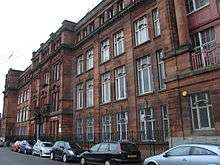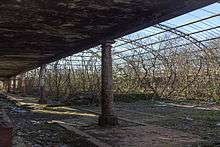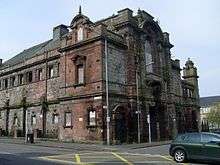Springburn
| Springburn | |
| Scottish Gaelic: Allt an Fhuairain | |
 Springburn |
|
| Population | 14,863 (2004) |
|---|---|
| OS grid reference | NS607678 |
| Council area | Glasgow City Council |
| Lieutenancy area | Glasgow |
| Country | Scotland |
| Sovereign state | United Kingdom |
| Post town | Glasgow |
| Postcode district | G21 |
| Dialling code | 0141 |
| Police | Scottish |
| Fire | Scottish |
| Ambulance | Scottish |
| EU Parliament | Scotland |
| UK Parliament | Glasgow North East |
| Scottish Parliament | Glasgow Maryhill and Springburn |
Coordinates: 55°52′59″N 4°13′43″W / 55.883141°N 4.228525°W
Springburn (Scottish Gaelic: Allt an Fhuairainn) is an inner city district in the north of the Scottish city of Glasgow, home to various working and middle-class households.
Springburn developed from a rural hamlet at the beginning of the nineteenth century. Its industrial expansion began with the establishment of a chemical works by Charles Tennant on the newly opened Monkland Canal at nearby St. Rollox in 1799, which later became part of the United Alkali Company.
Later in the 19th century the construction of railway lines through the area led to the establishment of Railway works and the village became a parish in its own right. The Garnkirk and Glasgow Railway first opened in 1831 to supply the St. Rollox Chemical Works and the Edinburgh and Glasgow Railway was opened in 1842. Later, the City Union Line was extended to Springburn in 1871 and the Hamiltonhill Branch Line opened in 1894.
Initially located outwith the Glasgow boundary, the area was eventually absorbed by the City of Glasgow Corporation in 1872.
Industrial development


The area's economic development has a strong historical link to heavy industry, particularly railways, with the manufacturing of locomotives. In the past, Springburn's locomotive industry had a 25% global market share.
There were four main railway manufacturing sites that located in Springburn; the North British Railway's (NBR) Cowlairs Works in 1841, the Caledonian Railway's St. Rollox Works in 1856, Neilson and Company's Hyde Park Works in 1861 and Sharp Stewart and Company's Atlas Works in 1888. The latter two eventually amalgamated to become part of the North British Locomotive Company (NBL) in 1903. Also located in Springburn is the Eastfield Running Shed, originally built by the North British Railway (NBR) near the Cowlairs Works in 1904.
St. Rollox became the largest works, and is the only one still in operation today, after the collapse of the North British Locomotive Company in 1962 and the closure of Cowlairs in 1968. In 2007 Railcare limited, who also own the Wolverton Railway Works site in Milton Keynes, took over operations at St. Rollox, from Alstom, who had originally acquired the works from BREL in the wake of the railway privatisation. After a significant refurbishment programme, the site currently operates as a Rolling stock repair and maintenance facility. The former Eastfield Running Sheds are now operated as a maintenance depot by First ScotRail and part of the former Cowlairs carriage sidings is now operated as a signalling and maintenance depot by Network Rail.
Another large industrial company operating in Springburn is Promat UK, which manufactures Passive fire protection materials at the Germiston Works on Petershill Road.
Social development

Springburn Park
The highest point in Springburn and of the City of Glasgow is its famous park on Balgrayhill, 364 feet above sea level. Springburn Park was opened by Glasgow Corporation in 1892 and laid out to a design by the City Engineer, Alexander B. McDonald. James Reid, a business colleague of locomotive manufacturer Walter Neilson, gifted a bandstand, built by the Saracen Foundry, to the park in 1893. His son Sir Hugh Reid of Neilson, Reid and Company's Hyde Park Works also gifted the lands of the adjacent Cockmuir Farm for the park to be extended to the east in 1900. It was at this time that the Reid family funded the construction of the Park's spectacular Winter Gardens, a £12,000 gift from Hugh Reid of the Hyde Park Works, as part of an arrangement for Glasgow Corporation to build a Public Hall in Springburn, both buildings however are currently derelict. A statue in honour of James Reid was erected in the park by public subscription in 1903.
Stobhill Hospital was later built adjacent to the park in 1904. Mosesfield House, situated in the park, was also the site where George Johnston built Britain's first Motor Car in 1895, which eventually grew to become the Arrol-Johnston company.
Barnhill Poorhouse
The Barnhill Poorhouse, had also opened at Springburn in 1850. Paupers who could not support themselves were sent here by the Parish and were obliged to work at jobs such as bundling firewood, picking oakum (separating tarred rope fibres) and breaking rocks. In 1905 the Glasgow Poorhouse in Townhead closed and its inmates went to Barnhill, making it the largest poorhouse in Scotland. In 1945 it was renamed Foresthall Home and Hospital and was thereafter used as a geriatric hospital and residential home. It was demolished in the late 1980s and a private housing development now stands on the site.
Sport
Local football team Cowlairs were a founder member of the Scottish Football League in 1890 but were bankrupt by 1896. Another local team, Northern also played in the SFL for a single season in the 1890s. Petershill was founded in 1897 and continues to play today at New Petershill Park, a modern stadium with a 2,000 capacity, including a 562-seat stand.
Regeneration



Springburn continued to see expansion, with the area incorporating housing schemes that were developed in the Interwar period, such as Balornock and also Post-war housing schemes such as those in Balgrayhill, Barmulloch and Sighthill. Barmulloch also included the High rise development at Red Road.
The old urban centre of Springburn was heavily affected by the redevelopment of the area from the early 1970s to the early 1980s. Selected as one of Glasgow's "Comprehensive Development Areas", Springburn saw the demolition of 85% of buildings in the district and the construction of a sequence of housing estates which transformed the area completely. A major dual carriageway, the A803 Springburn Expressway (originally designed to be the northern link to the aborted Glasgow Inner Ring Road) was completed as late as 1988. The handful of Victorian villas which remain around Balgrayhill and some sandstone tenements in Keppochill and central Springburn are only a fraction of what formed the dense urban community that had gone before. There are however various suburban middle class areas such as Forest Hall, Fernbank and Colston, which were largely unaffected by the redevelopment.
The regeneration vision remained incomplete, and by the mid-1980s Springburn had become one of Glasgow's most notorious areas, exacerbated by decaying housing and lack of major employers to replace the decline in the railway industry, despite the creation of North Glasgow College (now Glasgow Kelvin College) at the former North British Locomotive Company headquarters in 1965. Since then, there has however been further efforts to regenerate the area.
More recently the area of Keppochill Road, which links Springburn with Williamhill, Glasgow, has been regenerated through the work of the West of Scotland Housing Association Ltd, many of the Victorian sandstone tenement flats in Gourlay Street, Carlisle Street and Keppochill Road have been renovated and work continues to maintain and improve housing in the area.
New build developments in recent years has seen Glasgow Housing Association high-rise flats demolished or refurbished and new modern low rise houses built in the area. West of Scotland housing Association now has a head office based at 252 Keppochill Road however the interest of the charitable organisation extends into Ayrshire and Lanarkshire. The most notable surviving architectural feature in this area, the former Public Halls, was opened in 1902 and designed by William B. Whitie, who also designed Springburn's Public Carnegie library, which latterly formed Springburn Museum till it was closed in 2003. Since closing in the mid-1980s, the Springburn Public Halls fell into a state of chronic dereliction and were demolished in December 2012. The Springburn Library building now operates as the Glasgow North Regeneration Agency Conference Centre following a £2m refurbishment.
Social problems
Many social problems associated with poverty from crime to alcoholism and drug addiction have plagued the area for decades. In the 2001 census, nearly half of people in Springburn said they did not have any educational qualifications, the fourth highest figure in the UK, and almost two thirds said they had no car, second only to Shettleston.[1] That same year, it was reported that 40% of Springburn's residents were living in poverty, the area's unemployment rate was 140% higher than Scotland's average, deaths from lung cancer was twice the Scottish average and the proportion of children leaving school without Standard Grades was four times higher. The average household income was £13,310 and male unemployment stood at 13% - the highest level in Scotland.[2]
A study by CACI in 2010 found Springburn to be the most feared neighbourhood in Scotland for violent crime in a national league table, with 42% of residents living in fear of violence.[3]
In 2012, the "Scottish Index of Multiple Deprivation" analysis by the Scottish Government identified Springburn's Keppochhill as the third most deprived area in Scotland behind Ferguslie Park and neighbouring Possilpark.[4][5] According to a 2013 report, 51% of children in Springburn were living in poverty, the highest rate of child poverty in Scotland.[6][7]
Transport
The Springburn area is served by Springburn railway station and Barnhill railway station, offering regular commuter services on the North Clyde and Cumbernauld lines of the Glasgow suburban rail network. The area is also served by numerous bus routes.
Noted residents
Many people from Springburn have left their mark on the world, some of more the famous being Scottish International footballer James McFadden, singer (tenor) Sydney MacEwan, musician Duncan Campbell, comedian, author and talk show host Craig Ferguson, the evangelists and hymn writers Seth & Bessie Sykes, broadcasters and writers Tom Weir MBE and his sister Molly, the railway author John Thomas, the politicians John McAllion and Frank McAveety. Springburn's former MP, Michael Martin, was the Speaker of the House of Commons from 2000 to 2009. Martin Boyd, a local resident, was the last man in the UK hanged for rape.
- Duncan Campbell, musician
- Peter Capaldi, actor[8]
- Stevie Chalmers, footballer
- Marion Chesney, author
- Campbell Christie, trade unionist[9]
- Karl Denver, singer
- Agnes Dollan, political activist
- Robert Downie, World War I Victoria Cross recipient
- Valerie Edmond, actress[10]
- Armando Iannucci, writer[11]
- Mo Johnston, footballer
- Markee Ledge - Kosheen, musician/songwriter/DJ
- Sydney MacEwan, singer
- Jimmie Macgregor, folksinger[12]
- Frank McAveety, politician
- James McFadden, footballer
- Gavin Mitchell, actor[13]
- Billy Reid, footballer
- Alan Ross, footballer
- John Thomas, author
- Molly Weir, actress[14]
- Tom Weir, climber and broadcaster[15]
References
- ↑ Profile of Glasgow North East
- ↑ Motorway was the route to poverty and deprivation for Springburn
- ↑ Springburn tops league as nation’s most feared area for violent crime
- ↑ Ferguslie Park in Paisley is Scotland's most deprived area, new research shows
- ↑ Scottish Index of Multiple Deprivation 2012: Key findings
- ↑ Warning over high levels of child poverty
- ↑ Call to help Glasgow kids who are in poverty
- ↑ Peter Capaldi: 'People ask me to tell them to #@*! off'
- ↑ Interview: Campbell Christie
- ↑ Val is in the frame; The future looks bright for a lady with lots to Crow about
- ↑ Armando Iannucci: 'How I conquered America'
- ↑ Jimmie Macgregor early years
- ↑ Gavin Mitchell interview
- ↑ Molly Weir obituary
- ↑ Tom Weir biography
- Lowe, J.W., (1989) British Steam Locomotive Builders, Guild Publishing
- Thomas, John, (1964) The Springburn Story: The History of the Scottish Railway Metropolis, David & Charles
- Weir, M., (1970) Shoes Were For Sunday, Hutchinson
- Williamson, Elizabeth, et al. (1990) The Buildings of Scotland: Glasgow, Penguin
External links
-
 Media related to Springburn at Wikimedia Commons
Media related to Springburn at Wikimedia Commons - Springburn Virtual Museum
- Glasgow City Council's Springburn Park site
- History of Springburn with photographs and discussion